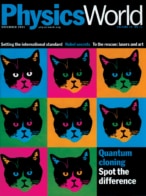As Open Access Week kicks off, Physics World talks to editorial board members of IOP Publishing’s open-access journals about their views on the future direction of open-access publishing

This week marks Open Access Week 2018, which has as its theme “designing equitable foundations for open knowledge”. Now in its 10th year, the global event aims to promote the benefits of open-access publishing.
To mark the week, Physics World has talked to editorial board members of IOP Publishing’s open-access journals to get their views on open access and its future. From the comments below, it seems that open access is becoming more popular in many areas of research. Yet challenges remain, particularly when it comes to cost and having the funds available in grants to pay for open-access publication.
How much demand for open-access publishing do you see in your research community and how is that changing? Do you see any notable regional differences?
Barry Sanders (BS), University of Calgary, Canada – editor-in-chief of New Journal of Physics
Green open access, which involves placing the paper behind an embargo, typically for 12 months, is widely used by the quantum-information community and has been ubiquitous for many years. Gold open access, in which the paper is made immediately available to read upon payment of an article processing charge (APC), is also popular in the community. Indeed, quantum information has been one of the strengths of New Journal of Physics – a gold open-access journal.
Sarbajit Banerjee (SB), Texas A&M University, US – senior advisory panel member on Journal of Physics Communication
Demand for open-access publishing is certainly increasing, with the biggest driving force being mandates from funding agencies – particularly for colleagues in Europe. Yet conflicts between perceived prestige and rigour on the one hand and open-access dissemination on the other hand, remain to be adequately resolved. Early-career researchers also face increasing institutional and cultural pressures to publish in high-impact-factor journals. The Venn diagram of overlap between high impact factor and open access is not substantial, albeit, encouragingly, it is not entirely null.
Eugenie Hunsicker (EH), Loughborough University, UK – senior advisory panel member on Journal of Physics Communication
Open-access publishing has huge benefits in terms of broadening access to new quality-controlled science papers. This has particular implications for scientists working in countries in which there is no extensive access to journals. The UK is currently putting more money than ever into developing research potential in these countries. Open access is critical for ensuring these efforts can flourish.
Open access is now a very exclusive club dominated by a few developed countries. The imbalance is worrisome
Arturo Sanchez-Azofeifa
Wilfried Winiwarter (WW), International Institute for Applied Systems Analysis, Austria – senior advisory panel member on Environmental Research Communications
There is a strong trend in environmental sciences towards open access. With public money typically funding this kind of research, funding bodies such as the European Union – via its Horizon 2020 programme – require that results are openly accessible. Many national funding bodies have also followed suit. Scientists are willing to adopt open-access practices if there is dedicated accessible funding available for open-access charges or project funding is sufficient to allow for open access. The current trend for open access has certainly been triggered by the availability of funds that allow the option of publishing in hybrid journals. With the increasing number of open-access publications, such funding has started to dwindle, so it is expected that the trend may reverse – unless research institutions themselves also adopt open-access policies, for which no general directions are currently visible.
Arturo Sanchez-Azofeifa (AS), University of Alberta, Canada – senior advisory panel member on Environmental Research Communications
There is a huge demand for open access in developing countries that have limited access to good scientific papers. As funding agencies start to request access to more open-source publications, it is not a matter of how, but when we will have 100% open access. Although some journals have discounts to publish open access, the costs can be extremely expensive. In my opinion open access is now a very exclusive club dominated by a few developed countries. The imbalance is worrisome.
Paul Palmer (PP), University of Edinburgh, UK – senior advisory panel member on Environmental Research Communications
There is already a massive appetite for open-access publishing in my research community. Many of the relatively new European-led journals already use a publishing model that includes the open-access publication of a “discussion” paper and the final paper. Although this model is not perfect by any means, the review process is more transparent than traditional publishing models that are used by some US journals. However, the situation in the US is beginning to change.
Dan Rubenstein (DR), Princeton University, US – reviews editor of Environmental Research Letters
Ease of access to a wide readership is advantageous given that funding agencies are supported by the tax payer and scientists want to reach colleagues all over the world. Open-access publishing helps facilitate this.
Daniel Kammen (DK), University of California, Berkeley, US – editor-in-chief of Environmental Research Letters
Demand for open access is very high and I am seeing requests from everywhere – hence the need for open access.
Thomas Anthopoulos (TA), King Abdullah University of Science and Technology, Saudi Arabia – senior advisory panel member of JPhys Materials
The volume of open-access papers seems to increase with time. I believe that in some countries the open-access route is dictated primarily by funding sources, rather than by the authors themselves.
What are the benefits of open-access publishing for researchers in your community?
BS: Researchers in quantum information appreciate the easy accessibility of gold open access for readers and the versatility that it offers as an online only service.
SB: The benefits are higher visibility of publications and the ability for researchers worldwide to easily access them. In disciplines with a more translational or applied emphasis, open access makes research accessible to industrial practitioners and thereby has the potential for greater impact. I think the emphasis on citations alone is misguided as a metric for evaluating such research.
Providing free access to research is a no brainer
Paul Palmer
WW: One of the biggest advantages of open access is that research can be easily distributed and accessed, which has proven to lead to higher citation rates. Also, copyright worries and posting of articles on websites are simplified. Scientists are normally not interested in legal issues – they want to access high-quality scientific literature and they wish their own research can be recognized as high quality by as large as possible a scientific community.
AS: When you make your papers open access you can open it up to a broad community and also make an impact via social media and other sources to promote your research. We are now asked to indicate in our grant applications how our research makes a difference; open access helps to answer that question.
PP: Open-access publishing allows everyone to access the latest research, which is often funded through public money. Providing free access to research is a no brainer. Open-access publishing generally improves the dissemination of information – not only for researchers in developing countries who may not have access to subscription-based journals, but also for teachers in schools so that they can more easily incorporate new findings into their lessons.
DR: Scientists want exposure to as many readers as possible, especially those in developing countries who do not have libraries paying the subscription costs for many of the major journals.
TA: Open-access publishing is welcomed especially by scientists in universities and countries with limited resources or at places where research is not a priority.
EH: Open access also has implications for scientists who have a break in their formal employment in science. This can cut off researchers from access to current research. Open access allows these individuals to keep on top of developments in their field and enable them to re-enter the scientific workforce again at a later point.
How do researchers in your community feel about funder mandates for open-access publication?
BS: Researchers in quantum information generally appreciate the importance of open access, especially now that quantum information is increasingly important to industry, investors and the public who face a paywall if the article is only available through subscription journals. On the other hand, many researchers feel trepidation that precious funding could diminish through paying APCs to publish research.
SB: I think researchers broadly are sympathetic to funder mandates and their intentions, but there is some wariness about “unfunded mandates” and whether APCs associated with open access become a barrier to entry.
WW: Such mandates are being recognized and are welcomed as long as there are no funding conflicts. Publishing costs remain quite low in the overall budget of a scientific project, but they have been increasing and cost is one criterion for selecting among high-quality journals. Researchers do have some liberty to allocate scientific articles to certain projects, but limitations in funding possibly takes some articles from being open access.
AS: I believe that people in our community do not have a problem with mandates. The problem is to have a mandate and not provide the dollars to fulfil it.
Publishing all of my work in open-access journals seems impossible, primarily due to limited funding
Thomas Anthopoulos
PP: A funder that mandates open access is happy to pay for it now but I suspect they are already questioning why some journals still have a two-tier system, with additional charges associated with an open-access option. I think the onus is on journals to change and with one or two notable exceptions most journals are beginning to dissolve the two-tier publication system.
DR: If scientists have grants they can often budget for the publication charge. If not, then open-access journals are off-limits.
DK: The main concern is the cost for people who have no budget for it in grants, which is very few.
TA: Publishing all my work in open-access journals seems impossible, primarily due to limited funding. However, this is changing at least in some countries around the world. So, one of the challenges we are currently facing is to balance traditional publication routes with open access.
EH: Open access can mean many different things. While in general the community is supportive of increasing access to publications, there is concern about the costs associated with publishing in certain types of open-access outlets. For some authors, this can be an insurmountable barrier to top-level publishing. There is also concern about the loss of revenues for professional societies, which have traditionally relied on journals for a large proportion of their charitable budget. Thus, there is concern that grants and activities will need to be cut if new policies drastically reduce this income.
What is the greatest challenge in ensuring open access is more equitable, accessible and fair?
BS: The greatest challenge is making open access affordable for all authors, especially in developing countries.
SB: We still need better models for APCs that are paid institutionally or by funders so that it does not become a barrier to entry. Open access must maintain standards for peer review and not be viewed as a watered-down version of rigorous science.
WW: The research landscape in general is not equitable, accessible or fair. National and cultural priorities make and create differences. General accessibility of open-access publications reduces such differences but open-access costs can again increase it. Allowing for waivers of such charges enhances equitability. If waivers are in place on a country-by-country basis, research programmes and activities that involve research in developing countries may also take advantage of joint open-access publications, such as in special issues.
AS: There are two important challenges. The first is funding to support open access. This should not come out of current allocations. A funding agency should not provide the same level of funding as before and add the expectation that papers will be open access. The second challenge is the democratization of research. We need to try to allow developing countries to publish in good open-access journals. It is nice to have journals that are open access if they remain controlled by researchers with associated funding from developed countries it will make little difference. An effort to bring scientists from developing countries into the open-access realm is fundamental and necessary.

The reality of open access
PP: I think the greatest challenge for publishers is to justify their continued existence. As the global scientific community grows, so does its output. At the same time, scientists want their information to be shared quicker so repositories like arXiv continue to grow in importance. The primary role for a journal is to maintain a reputation for quality research using rigorous peer review but in some cases this reputation is already being eroded, perhaps overwhelmed, by the volume of papers being submitted.
DR: Costs. Someone has to pay for publication but somehow an egalitarian model has to be created where those who can, pay, and those who cannot need to be subsidized. But in today’s online world, the cost of publishing work should be lower than in the past. Until the costs are reduced, most scientists will go where they do not have to pay, or at least do not have to pay as much. Grants are always smaller than desired and money for publishing has the lowest priority.




